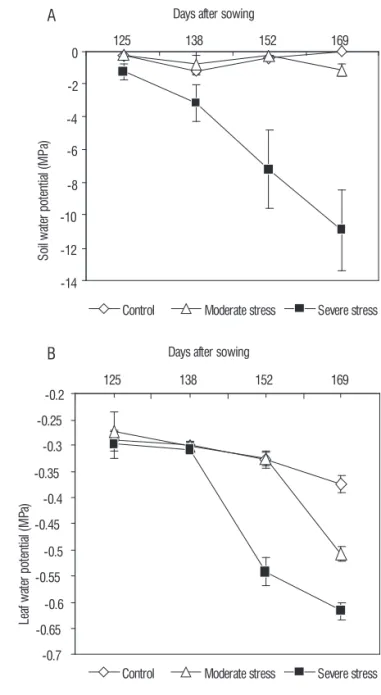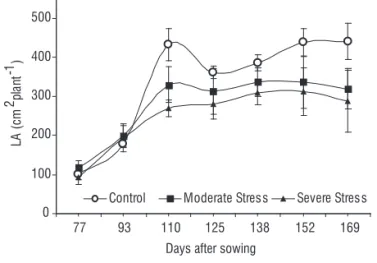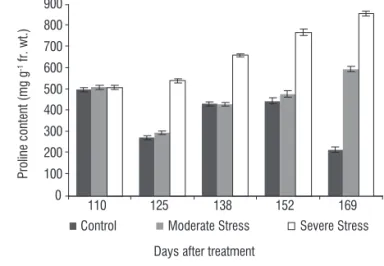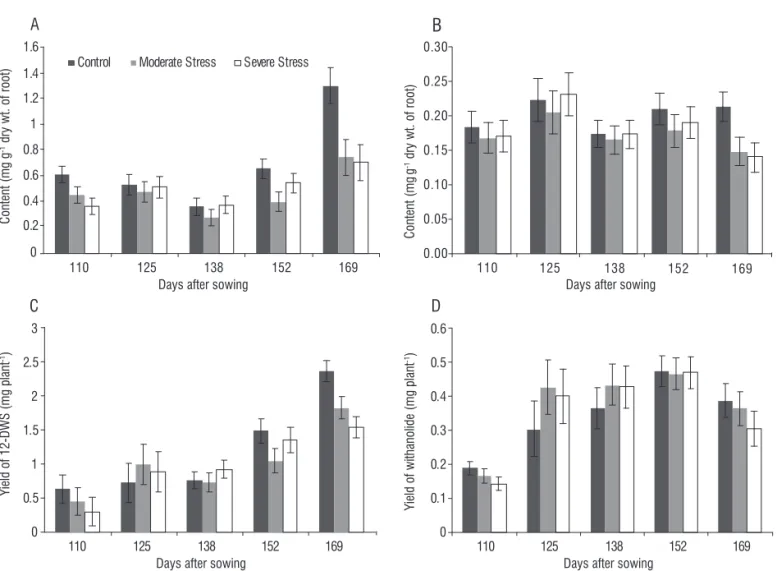Phytochemical and physiological changes
in Ashwagandha (
Withania somnifera
Dunal)
under soil moisture stress
Sonal Shah, Raju Saravanan
*and Narendra Atmaram Gajbhiye
Directorate of Medicinal and Aromatic Plants Research, Boriavi PO, 387 310, Anand, Gujarat, India
* Corresponding author: Tel: +91-2692-271 605 extension 209; Fax: +91-2692-271601; Email: sarav_nrc@ yahoo.com, rajusar@gmail.com
Received: 29 July 2010; Accepted: 04 February 2011
ABSTRACT
Ashwagandha, commonly known as the Indian Ginseng (Withania somnifera) is an ingredient in many herbal preparations used for healing various ailments. It is cultivated in semi-arid regions of India as rain-fed crop. The response of this crop (cv. JA-134) to progressive soil moisture deficit on growth, physiology and content of phytochemicals was studied. At the end of treatment period, soil water potential (Ψw) decreased to -10.93, -1.15 MPa at 30 cm depth, predawn leaf water potentials were reduced to -0.62 and -0.51 MPa in the severe and moderate stress. Leaf area was reduced by 27.4% and 34.4% in moderate and severe water stress treatment compared to control. Chlorophyll content was reduced by 60% in the severe water stress. Changes in the steroidal alkaloids and lactones that are the major medicinal active principles derived from root extracts of this plant species was also analyzed. A reduction of 52.6% in net photosynthesis was noticed under severe stress. At the end of the treatment period, moderate and severe stress treatments had 0.751 and 0.714 mg g-1 12-deoxywithastramonolide (12-DWS) content in the roots respectively. The content of 12-DWS and withanolide were at 77% and 93% of the control in the moderate and severe stress, respectively, while yield of these compounds were at 65% and 78% of control in mild and severe stress. Thus, preferential partitioning of biomass in roots leads to higher root yield in moderate stress. Higher root yield partially offset the loss of bioactive compounds under soil moisture stress.
Key words: medicinal plant, secondary metabolites content, soil moisture stress, withanolide content
INTRODUCTION
Drought stress, characterised by low availability of soil moisture and high evapo-transpiration is considered one of the principal causes which decrease crop productivity worldwide (Boyer, 1982; Araus et al., 2002). Soil moisture deficit perceived as drought stress results in drop in water potential in plants. As this condition develops, responses of a wide range of physiological and biochemical processes are induced. Some of these responses are directly triggered by the changing water status of the tissues while others are brought about by plant hormones that are signaling changes in water status (Chaves
for animal and human health care (Ehrlich and Raven, 1964; Coley and Barone, 1996; Nina and Lerdau, 2003). Understanding how declining soil moisture influence the growth, biomass portioning in different organs and production of secondary metabolites have attracted considerable attention for optimizing the field growth conditions for higher productivity and maximal recovery of phyto-medicines.
Ashwagandha, Withania somnifera Dunal (Solanaceae), known as “Indian ginseng” is a reputed medicinal herb grown for its roots in arid and semi-arid regions of many countries. Roots of this plant form ingredients of many herbal formulations prescribed for musculoskeletal conditions, nervous system and as a general health tonic for elderly persons and lactating mothers (Bone, 1996). Steroidal alkaloids and lactones in a class of constituents called withanolides are the major active principles of W. somnifera roots (Grigorescu et al., 1990). It is grown as rain-fed crop in many parts of India under arid and semi-arid regions. It grows well in soils having residual moisture and single or two supplementary irrigations during the entire period of its growing season. Despite its drought tolerance capacity, prolonged soil moisture deficit inhibits the growth and development of the crop and adversely affects the crop yield potential and plant productivity. Understanding the effect of long duration moisture stress on the active principle content and root quality will help to augment functional characterization and biochemical integration of molecular and genetic data. The objectives of this study were to understand the response of field grown W. somnifera to soil moisture deficit and the changes in root secondary metabolites productivity .
MATERIALS AND METHODS
Plant material and treatment: The study was carried out at Directorate of Medicinal and Aromatic Plants Research (DMAPR), Boriavi, Anand, Gujarat, India (N 22○55’, E 072○66’, MSL – 45m). The average rain fall was 800 mm and maximum - minimum temperature ranged between 42°c and 12.7 °C. The soil was sandy loam and had pH 7-7.5 with water holding of 20-22%. The experiment was conducted during winter and spring season (October 2008 - April 2009). The design was RBD with three treatments (non-stress control, moderate and severe water stress) with 7 replications each. Seeds of Withania somnifera Dunal cv JA 134 were sown in lines with 30 cm line spacing and 20 cm between plants on 15 October 2008 and
standard cultural practices were carried through out the crop growth period. Life irrigation was given immediately after sowing. The severe water stress treatment received one additional flood irrigation (67 DAS,-days after sowing, i.e. 22 December 2008) and mild stress had two irrigations (67 DAS, 22 December 2008 and 114 DAS, 7 February 2009), whereas control treatment received four irrigation (67 DAS, 22December 2008; 114 DAS, 7 February; 153 DAS, 18 March and 168 DAS, 2 April 2009).
Measurement of soil and leaf water potential:The water potential of soil was measured based on moisture release curve developed for a range of soil moisture content and resultant Ψsoil using soil chamber psychrometer (Wescor Inc, USA) following Wacker, 1999. At each sampling date, leaf water potential (Ψ) of fully expanded leaf was measured with a pressure chamber (3005 Pressure Extractor, Soil Moisture Equipment Corp., Santa Barbara, CA, USA) at pre-dawn. The leaf was inserted inside the pressure chamber in such a way that ~3-5 cm of the petiole remains outside and slowly air pressure was increased with nitrogen gas flow. Pressure at which xylem sap flow was initiated at the cut end was noted as Ψ of leaf sample.
Measurement of leaf area and biomass production: The leaf area measured for five plants from each replication at every sampling dates using Leaf Area Meter (LI – 3100 Area meter, LICOR, Lincoln, NE, USA). The total leaf area of plant was estimated immediately after the samples were collected from plots. Three to five plants were collected at each sampling date for the measurement of fresh and dry weight. Plants were weighed individually for their fresh weight and kept in brown paper bags. Bags were than kept for 24-36 hr in oven at 60°C. Finally dry weight was determined by weighing the dried roots, stem, leaves, using precision balance.
Determination of reducing sugars and proline content: The proline content in leaf tissue was analyzed by the method using sulpho-salicylic acid and acid ninhydrin (Bates et al., 1973).
The reducing sugar was analyzed by modified Somogyi method (Somogyi, 1952).
times to get 150 ml of extract and it was evaporated using a rotary evaporator at 550 mbar pressure at 55o C. Remaining residue was dissolved in 15 ml mobile phase and centrifuged at 10,000 rpm for 10 min. The supernatant was used for HPLC analysis. Mobile phase used was isocratic with Acetonitrile (40%): Water (60% in 0.1% orthophosphoric acid). Withanolide and 12-deoxywithanostramonolide (Sigma-Aldrich, USA) standard compounds were used for the quantification. Data were analyzed by analysis of variance (ANOVA) with the help of MSTAT C program to detect significant difference between means. Variability in data has been expressed otherwise as mean standard error. The values are mean ± SD for six samples in each group. P values=0.05 were considered as significant.
RESULTS AND DISCUSSION
Soil (Ψsoil) and leaf water potential (Ψleaf) in control, mild
stress and severe stress treatments were presented in Figure 1A & 1B respectively. The Ψsoil varied narrowly in both control and moderate stress treatments and maintained at -1.0 MPa at 30 cm depth throughout the growing periods. The Ψsoil in severe stress treatment which received only one irrigation 67 days after sowing (DAS) did not vary significantly during the initial stages soil moisture depletion. However, at later stages Ψsoil showed declining trend from -1.22 MPa at 125 DAS to -10.93 MPa at 169 DAS. It did not vary during the period up to 125 DAS and it took another 56 days to reach this extreme soil water potential value. Even though the Ψsoil reached values near to -2.0 MPa at 125 DAS in the severe stress, it did not translate into reduced Ψprobably due to the availability moisture in the deeper soil layers. Plants responded to decreasing soil moisture at the early stage of stress signals by increasing the root biomass and growth, which in turn help the plant to explore deeper soils for available water.
Pre-dawn leaf water potential presented in Figure 1-B is a good indicator of plant water stress, which remained constant in the control plants during the period of study. Predawn leaf water potential (Ψ) decreased in the mild and severe stress plants during the course of the water stress treatment period. After 125 DAS, predawn potentials were -0.29, -0.27 and -0.30 MPa for the control, moderate and severe water stress plants, respectively (Figure 1B). However, the Ψleaf started declining in the
severe stress and reached -0.62 MPa at 169 DAS whereas the control and mild stress had -0.37 and -0.51 MPa, respectively.
Severe water stressed plants exhibited a difference of -0.24 MPa which is well in agreement with the loss of soil moisture and due to the extreme Ψsoil recorded in this treatment.
-14 -12 -10 -8 -6 -4 -2
0 125 138 152 169
Days after sowing
So
il w
ate
r p
ote
nt
ia
l (MPa
)
Control Moderate stress Severe stress
A
B
Control Moderate stress Severe stress
-0.65 -0.6 -0.55
-0.5 -0.45
-0.4 -0.35
-0.3 -0.25 -0.2
125 138 152 169
Days after sowing
Le
af
wa
te
r pot
ent
ia
l (
M
Pa
)
-0.7
Figure 1. Changes in soil (A) and leaf water potential (B) of W. somnifera
plants undercontrol and water stress conditions (the data represent mean ±
SD, n=7; p < 0.05).
of control, respectively, in mild and severe stress. The results showed that LA was more sensitive to soil moisture regimes than other growth parameters. Positive associations between green leaf area duration and grain yield have been observed in a range of cereals, including wheat (Evans et al., 1975); maize (Tollenaar and Daynard, 1978; Wolfe et al., 1988); oat (Helsel and Frey, 1978); and sorghum (Henzell et al., 1992). With progressive stress period, LA was substantially reduced in W. somnifera although new leaves have developed under mild and severe stress. However, the leaves were significantly smaller compared to control plants. With increasing stress intensity leaves showed curling and older leaves tend to wither and fell off due to accelerated leaf senescence. The ability of leaf curling is an adaptive morphological trait restricting the transpiration and promoting water retention in leaf tissues. Studies in other crops showed that senescence of old leaves might be accelerated by stress conditions (Stocker, 1960; Hang and Miller, 1986). Leaf senescence promoted the translocation of essential nutrients to growing tissues which support the crop to maintain the growth even under severe moisture stress.
0 100 200 300 400 500
77 93 110 125 138 152 169
Days after sowing
LA
(
cm
2 pl
an
t
-1 )
Control Moderate Stress Severe Stress
Figure 2. Pattern of leaf area (LA) development in stressed and control plants
W. somnifera (the data represent mean ± SD, n=7; p < 0.05).
At early growth stages, root:shoot ratio in control and stressed plants were higher and decreased sharply till 110 DAS and recovered gradually. The increase in root:shoot ratio was higher in both under moderate and severe stress compared to well watered control (Figure 3). The trend reversed after 138 DAS and decreased steadily until the end of the treatment period. However, higher root:shoot ratio was sustained in stressed plants with high root biomass
compared to control. Root growth was enhanced under stress with increasing stress intensity. The response of plant to drought signal was initiated at the early stage itself and the dry weight of root (DWR) showed significant increase over control at 54 days. Several studies in other crops showed the increased rooting, root length, more number of fine roots at the onset of drought with increased portioning of biomass accumulation in roots. It is likely that increased root/shoot ratio helps reduce transpiration rate and prevent the excessive desiccation (Stocker, 1960) under water stress. The increased root growth and root system development helps the plant to explore the wider area of soil and into the deeper soil layers for water. From measured soil water extraction Allen et al. (1976) concluded that during water stress, roots of ground nut in lower depths continue to grow deeper even though vegetative growth appears to stop.
0 0.2 0.4 0.6 0.8 1
77 93 110 125 138 152 169
Days after sowing
R
oot
-s
hoot
rat
io Control
Moderate Severe
Figure 3. Changes in root:shoot ratio of W. somnifera at different growth
stages under control and soil moisture stress(the data represent mean ±
SD, n=7; p < 0.05).
Similarly, content of reducing sugars at different stages of crop growth varied significantly among the treatments. All the treatments showed similar reducing sugar (Sr) content at the initial stages as well as at 125 DAS and 138 DAS (Figure 4). Even as the Sr showed increasing trend in the control, it
was reduced in the stress treatments. The content of Sr in
0 10 20 30 40 50 60
125 138 152 169
Days after treatment
Moderate Stress Severe Stress
Control
R
educi
ng
s
ug
ar (m
g g
-1 fr. wt.)
Figure 4. Changes in reducing sugar content in leaves of W. somnifera at
different growth stages under control and soil moisture stress(the data
represent mean ± SD, n=7; p < 0.05).
The results showed that proline is accumulated in substantial amounts in the leaves of W. somnifera under soil moisture stress (Figure 5). At early growth stages the content of proline in leaf tissues of control and stressed plants were almost identical. However, with increasing stress intensity moderate stress and severe stress had 2.75 and 3.96 times that of control at 169 DAS. Accumulation of proline in the plants and its role in osmotic adjustment is well established. Proline content in leaves positively correlated with the intensity of soil moisture stress. Proline accumulation helps in maintenance of cell metabolism with decreasing water status, enabling plant survival under extremely severe conditions. Proline is suggested to play several roles in plants exposed to stress. It acts as osmolyte to protect the cell turgidity under dehydration stress and prevent structural damage to macromolecules during desiccation. The high proline content is likely to depress reactive oxygen species level due to the involvement of proline in detoxification of superoxide radical. Several studies show that the levels of proline are more specifically regulated than the other solutes during adjustment to stress. The results indicated greater accumulation of solutes in stressed plants which had lower leaf water potential as compared to that in control. In fact, osmolytes accumulation increased with the increase in soil moisture stress, as a stress induced plant adaptation through accumulation of solutes (Morgan, 1984; Ludlow and Muchow, 1988). Such a favorable effect of osmolytes accumulation on yield and its components could presumably be attributed to the well-established role of osmolytes accumulation in maintaining turgor pressure in cells and plant growth under water deficit as observed in various crops.
0 100 200 300 400 500 600 700 800 900
110 125 138 152 169
Proline content (mg g
-1 fr. wt.)
Days after treatment
Moderate Stress Severe Stress
Control
Figure 5. Changes in proline content in leaves of W. somnifera at different
growth stages under control and soil moisture stress(the data represent
mean ± SD, n=7; p < 0.05).
0 0.5 1 1.5 2 2.5 3
110 125 138 152 169
C 0 0.2 0.4 0.6 0.8 1 1.2 1.4 1.6
110 125 138 152 169
Days after sowing Days after sowing Control
0.00 0.05 0.10 0.15 0.20 0.25 0.30
110 125 138 152 169
B
Days after sowing
Content (mg
g
-1 dry wt. of root)
Content (mg g
-1 dry wt. of root)
Yield of 12-DWS (mg plant
-1)
0 0.1 0.2 0.3 0.4 0.5 0.6
110 125 138 152 169
D
Days after sowing
Yield of withanolide (mg plant
-1)
Moderate Stress Severe Stress
A
Figure 6. Effect of soil moisture deficit on 12-deoxywithanostramonolide content (A), withanolide content (B), per plant yield of 12-deoxywithanostramonolide (C)
and yield of withanolide (D) of W. somnifera. Values are mean ± SD; n=7.
The quality parameters other than active principle content in root in terms of root structure, such as the root colour and texture improved under stress conditions. With higher soil moisture, roots were thin and highly branched and fibrous which render them unacceptable. Little information is available regarding response of W. somnifera to prolonged soil moisture stress. This study could help understand some adaptive mechanism developed by W. somnifera and contribute to the understanding secondary metabolisms of this crop and to identify physiological and biochemical traits for root quality and yield under low moisture regimes.
Acknowledgement: Authors are thankful to the Director of DMAPR for providing facilities for this work.
REFERENCES
Allen LH, Boote KJ, Hammond LC (1976) Peanut stomatal diffusive resistance affected by soil water and solar radiation. Proc. Soil Crop Sci. Soc. 35: 42-46.
Araus JL, Slafer GA, Reynolds MP, Royo C (2002) Plant breeding and drought
in C3 cereals: What should we breed for? Annal Bot. (London). 89:925-940.
Bates LS, Waldren RP, Teare ID (1973) Rapid determination of free proline in water stress studies. Plant Soil. 39:205-208.
Bone K (1996) Clinical Applications of Ayurvedic & Chinese Herbs. Monographs
for the western Herbal Practitioner. Phytotherapy Press, Australia.
Boyer JS (1982) Plant productivity and environment. Science. 218:443-448.
Chaves MM, Maroco JP, Pereira JS (2003) Understanding plant responses to drought–from genes to the whole plant. Func. Plant. Biol. 30:239-264.
Coley PD, Barone JA (1996) Herbivory and plant defenses in tropical forests. Annu. Rev. Ecol. Syst. 27:305-335.
Ehrlich PR, Raven PH (1964) Butterflies and plants: a study in coevolution. Evolution. 18:586-608.
Elsakka M, Grigorescu E, Stanescu U, et al. (1990) New data referring to
chemistry of Withania somnifera species. Rev. Med. Chir. Soc. Med. Nat.
Iasi. 94:385-387.
Evans LT, Wardlaw IF, Fischer RA (1975) Wheat. pp. 101-150.
Hang AN and Miller DE (1986) Response of sugar beet to deficit, high frequency sprinkler irrigation. II: Sugar beet development and partitioning to root growth. Agron. J. 78:15-18.
Helsel DB, Frey KJ (1978) Grain yield variations in oats associated with differences in leaf area duration among oat lines. Crop Sci. 18:765-769.
Henzell RG, Brengman RL, Fletcher DS, McCosker AN (1992) Relationships between yield and non-senescence (stay-green) in some grain sorghum hybrids
grown under terminal drought stress, in:Foale, M.A., Henzell, R.G., Vance,P.N.,
(Eds) Proceedings of the second Australian Sorghum Conference, Gatton, Feb 4-6, Occasional Publication.
Ludlow MM, Muchow RC (1990) A critical evaluation of traits for improving crop yields in water-limited environments. Adv. Agron. 43:107-152. Morgan JM, (1984) Osmoregulation and water stress in higher plants. Annu. Rev. Plant Physiol. 35:299-319.
Nina T, Lerdau M (2003) The evolution of function in plant secondary metabolites.
Int. J. Plant Sci. 164:93-102.
Somogyi M (1952) Notes on sugar determination. J. Biol. Chem. 195:19–23. Stocker O (1960) Physiological and morphological changes in plants due to water deficiency. In: Plant water relationships in arid and semiarid conditions. Rev. Res. UNESCO, (Paris) 15:63-104.
Tollenaar M, Daynard TB (1978) Effect of defoliation on kernel development in maize. Can. J. Plant Sci. 58:207–212.



